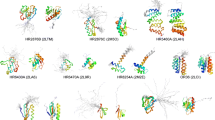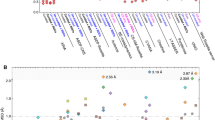Abstract
We present an analysis of the results obtained at CASD-NMR round 3 by the CHESHIRE and the YAPP methods. To determine protein structures, the CHESHIRE method uses solely information provided by NMR chemical shifts, while the YAPP method uses an automated assignment of NOESY spectra. Of the ten targets of CASD-NMR round 3, nine CHESHIRE predictions and eight YAPP ones were submitted. The eight YAPP predictions ranged from 0.7 to 1.9 Å Cα accuracy, with an average of 1.3 Å. The nine CHESHIRE predictions ranged from 0.8 to 2.6 Å Cα accuracy for the ordered regions of the proteins, with an average of 1.6 Å. Taken together, these results illustrate how the NOESY based YAPP method and the chemical shift based CHESHIRE method can provide structures of comparable quality.





Similar content being viewed by others
References
Cavalli A et al (2007) Protein structure determination from NMR chemical shifts. Proc Natl Acad Sci USA 104(23):9615–9620
Cavalli A, Montalvao RW, Vendruscolo M (2011) Using chemical shifts to determine structural changes in proteins upon complex formation. J Phys Chem B 115(30):9491–9494
Fu B et al (2014) ALMOST: an all atom molecular simulation toolkit for protein structure determination. J Comput Chem 35(14):1101–1105
Guntert P, Mumenthaler C, Wuthrich K (1997) Torsion angle dynamics for NMR structure calculation with the new program DYANA. J Mol Biol 273(1):283–298
Habeck M et al (2004) NOE assignment with ARIA 2.0: the nuts and bolts. Meth. Mol Biol 278:379–402
Herrmann T, Guntert P, Wuthrich K (2002) Protein NMR structure determination with automated NOE assignment using the new software CANDID and the torsion angle dynamics algorithm DYANA. J Mol Biol 319(1):209–227
Jain A, Vaidehi N, Rodriguez G (1993) A fast recursive algorithm for molecular-dynamics simulation. J Comput Phys 106(2):258–268
Moult J, et al (1995) A large-scale experiment to assess protein structure prediction methods. Proteins 23(3):ii–v
Rosato A et al (2009) CASD-NMR: critical assessment of automated structure determination by NMR. Nat Methods 6(9):625–626
Rosato A et al (2012) Blind testing of routine, fully automated determination of protein structures from NMR data. Structure 20(2):227–236
Shen Y et al (2009) TALOS+: a hybrid method for predicting protein backbone torsion angles from NMR chemical shifts. J Biomol NMR 44(4):213–223
Siew N et al (2000) MaxSub: an automated measure for the assessment of protein structure prediction quality. Bioinformatics 16(9):776–785
Zhang Z et al (2014) Robust and highly accurate automatic NOESY assignment and structure determination with Rosetta. J Biomol NMR 59(3):135–145
Conflict of interest
The authors declare that they have no conflict of interest.
Author information
Authors and Affiliations
Corresponding author
Rights and permissions
About this article
Cite this article
Cavalli, A., Vendruscolo, M. Analysis of the performance of the CHESHIRE and YAPP methods at CASD-NMR round 3. J Biomol NMR 62, 503–509 (2015). https://doi.org/10.1007/s10858-015-9940-9
Received:
Accepted:
Published:
Issue Date:
DOI: https://doi.org/10.1007/s10858-015-9940-9




